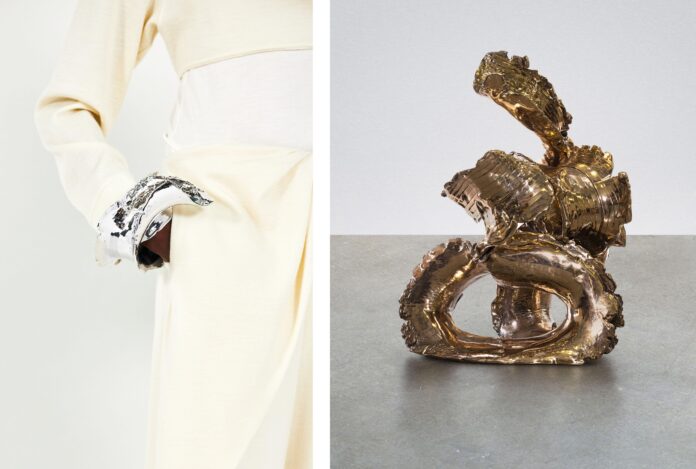A high-end fashion house and a giant of postwar US sculpture known for brandishing an eye-watering dildo in a 1970s image joined forces last week. Lynda Benglis, who posed with the sex toy for Artforum in 1974, showed six recent large-scale bronze sculptures at Loewe’s runway presentation in Paris on 29 September (women’s collection, spring 2024).
Benglis has been celebrated for her vibrant colour and process-oriented abstract art, which includes poured latex floor paintings, cantilevered foam urethane sculptures, totemic wax paintings, tubular knots and biomorphic mounds or spheres in bronze, lead and glass.
In November 1974, at the height of the feminist movement, Benglis gained notoriety for a racy photo she made in a bid for publicity. It pictured her in the nude, except for a pair of white-framed sunglasses and a heavy layer of oil on her skin, wielding an exceptionally large double-headed dildo. In a 2011 interview in The Art Newspaper, she said that the dildo “may be in my jewellery box”.
Earlier this year, three water-spouting fountains by Benglis, including the piece Crescendo, lined the catwalk at Loewe’s menswear collection show. Her influence and ideas also permeated Loewe’s latest presentation. The show invite was an ultra shiny chrome number emblazoned with an image from an invitation card for Benglis’s exhibition at Paula Cooper Gallery in New York in 1978. The artist’s hand could also be seen in a range of jewellery pieces sported by the androgynous catwalk models.
Rings, brooches, earrings and pendants—all worn on the runway and dovetailing with the sculptural assemblages—have been created as “knotted, pleated, poured and extruded wearable sculptures”, a Loewe statement says. Andrew Bonacina, a curator and art consultant working for Loewe who has overseen the Benglis project, explained that Benglis began working on the jewellery maquettes in June but this is the first time “she has explored the wider range of possibilities” in the medium.
During the Loewe show—attended by actor Kit Connor, global editorial director of Vogue, Anna Wintour, and reality TV star Kris Jenner—models in chunky jumpers, flowing capes and high-waisted trousers weaved themselves around Benglis’s compositions cast from a series of clay sculptures entitled Elephant Necklace. The elongated forms, hanging in the air like unfinished abstract swirls, proved to be a brilliant backdrop to the clothing displayed on the catwalk. Sculptures on show included Black Widow (2021) and Yellow Tail (2020).
“Lynda is fascinated seeing these works in this context. She is always interested in the body and ideas of movement so the idea of models moving around them excites her,” says Bonacina.
“To make the original forms [of the sculptures] she pushes the clay through an extruder to create soft lengths which she then twists to create the piece. The enlargements show all of her manipulations; you can see her fingerprints and the torn edges of the clay. She is always interested in what materials can do so the works evidence the process,” Bonacina says. The sculptures will in turn be returned to Benglis’s studio. The Loewe runway show is a “survey of her forms, techniques and materials in miniature”, he adds.
Backstage he outlined how she created the jewellery; for instance, how the rings originated from her sparkled and painted paper pieces that she has been working on for more than a decade. “We looked at these small fragments of paper covered in glitter in her studio and played around them; we chose a selection, scanned them and created rings, earrings and ear cuffs.”
Some of the items were made from polyurethane foam, literally “squirted out of can and cast in sterling silver”. The fact that the objects can “be worn and move” on the body is how they come to life for Benglis, he says.
Benglis says on Instagram that “the body sculptural idea has always interested me. In fact jewellery is the first thing that I noticed when I was a kid and that led me into making art. It was a way of making large jewellery when I did the sculpture… I realised that the sculptors were all so serious. This heavy lead, these heavy pieces, so I explored lightweight plastics and colour—all the elements of toys and jewellery.”

























